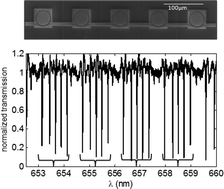An efficient technique for the reduction of wavelength noise in resonance-based integrated photonic sensors
Abstract
A systematic study of the limit of detection (LOD) in resonance-based silicon photonic lab-on-chip sensors is presented. The effects of the noise, temperature fluctuations, and the fundamental thermodynamic limit of the resonator are studied. Wavelength noise is identified as the dominant source of noise, and an efficient technique for suppressing this noise is presented. A large ensemble of statistical data from the transmission measurements in a laser-scanning configuration on five silicon nitride (SiN) microrings is collected to discuss and identify the sources of noise. The experimental results show that the LOD is limited by a 3σ wavelength noise of ∼1.8 pm. We present a sub-periodic interferometric technique, relying on an inverse algorithm, to suppress this noise. Our technique reduces the wavelength noise by more than one order of magnitude to an ensemble average of 3σ = 120 fm, for a resonator quality factor (Q) of about 5 × 104 without any temperature stabilization or cooling. This technique is readily amenable to on-chip integration to realize highly accurate and low-cost lab-on-chip sensors.


 Please wait while we load your content...
Please wait while we load your content...